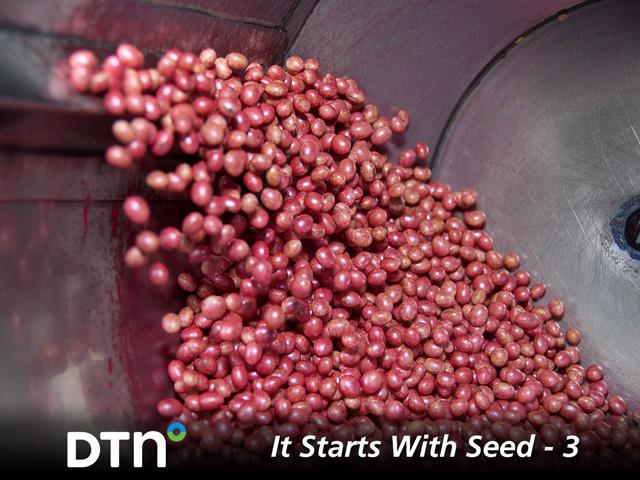It Starts With Seed - 3
Chart Identifies Seed Treatment Products, Active Ingredients
Think of the seed as real estate. Not open-range country but instead a crowded city block stacked with many occupants.
A growing array of insecticides, fungicides, nematicides and plant growth regulators get coated onto crop seeds these days. Some of it comes preloaded on the seed in complicated proprietary treatments. Other times, you may be asked to pick and choose from a cafeteria of options.
In upcoming days, DTN/Progressive Farmer is posting a special series called It Starts With Seed, to help farmers start thinking about their seed purchases and preparing for next year. In this, the third story of the series, we provide a source for details on seed coating options.
CHART HELPS SORT OPTIONS
A chart called "What's on Your Seed?" is designed to help you sort out these options. It lists every active ingredient and seed-treatment package registered for use on seeds in Wisconsin, but the list should cover the major options for all U.S. row-crop growers, said Damon Smith, who developed the chart along with Richard Proost, both University of Wisconsin scientists.
"It's meant to be a CliffsNotes to the seed-treatment world to get people to pay attention to what's on their seed and make informed decisions about the treatments they use," Smith said.
P[L1] D[0x0] M[300x250] OOP[F] ADUNIT[] T[]
Those decisions have only gotten harder since Smith joined the University of Wisconsin team in 2012 and started helping Proost, a now-retired agronomist with the university's Nutrient and Pest Management program, with the chart.
That year, the chart listed 102 distinct branded seed-treatment products containing 27 unique active ingredients, mostly fungicides. It was a lot of products, but it fit on one page.
That's no longer the case.
In the past decade, the number of seed-treatment packages listed on the chart has nearly tripled to more than 260. The active ingredients they contain have just about doubled to 56.
The chart now fills seven pages and has become an invaluable dictionary for crop consultants, farmers, industry and others.
"I think we're starting to realize that, amid this push to put a seed treatment on everything, a lot of farmers don't actually know what is on their seed," Smith noted.
Crop consultants sorting through product offerings are the most common users of the chart, but farmers stand to benefit just as much from it, he added.
"When something goes wrong in the field, you need to be able to backtrack and see what you used," he said. "Or, if you know what you need, it can help you find something that fits your operation."
The chart's value to farmers has not gone unnoticed; last year, it won an award from the American Society of Agronomy for excellence in educational Extension materials.
You'll find the chart on the University of Wisconsin's Integrated Pest and Crop Management website, https://ipcm.wisc.edu/…, where it's updated each year.
**
Editor's Note: This is the third of the stories in our special It Starts With Seed series. Next in the series: A look at a Handy Bt Trait table that clarifies insect traits.
Emily Unglesbee can be reached at Emily.Unglesbee@dtn.com
Follow her on Twitter @Emily_Unglesbee
(c) Copyright 2021 DTN, LLC. All rights reserved.





